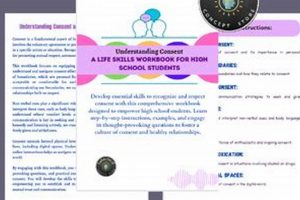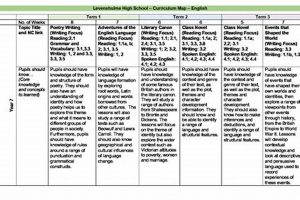These courses offer secondary students an introduction to healthcare professions outside of traditional medicine and nursing. They typically cover a range of disciplines, including medical assisting, physical therapy, emergency medical services, dental hygiene, and nutrition. For instance, students might learn basic medical terminology, first aid procedures, or the fundamentals of patient care. Practical exercises, such as taking vital signs or simulating emergency scenarios, are often incorporated.
Early exposure to healthcare careers provides several advantages. It allows students to explore diverse career pathways and potentially discover a passion for a specific field. Such programs can also cultivate essential skills, like teamwork, communication, and problem-solving, which are valuable in any profession. Historically, these educational opportunities emerged in response to a growing demand for skilled healthcare professionals and the recognition that early career exploration can contribute to a more robust and prepared workforce.
This foundation provides a springboard for further exploration into topics such as curriculum development, career pathways within the field, and the role of these programs in addressing the evolving needs of the healthcare industry.
Tips for Success in Healthcare Career Exploration
Strategic planning and focused effort enhance the value of introductory healthcare courses. The following tips offer guidance for maximizing the learning experience and preparing for future career opportunities.
Tip 1: Active Participation: Consistent engagement in classroom discussions and activities solidifies understanding of key concepts. Active learning promotes retention of information related to medical terminology, procedures, and patient care.
Tip 2: Networking: Connecting with professionals already working in allied health fields provides valuable real-world insights. Informational interviews or job shadowing experiences can offer firsthand perspectives on career paths and daily responsibilities.
Tip 3: Research: Independent exploration of various allied health professions clarifies personal interests and career goals. Thorough research into specific roles, required education, and projected job market trends informs decision-making.
Tip 4: Skill Development: Focusing on cultivating relevant skills, such as communication, teamwork, and problem-solving, strengthens one’s candidacy for future opportunities. These skills are transferable across various healthcare disciplines.
Tip 5: Seek Mentorship: Establishing a mentor relationship with an experienced healthcare professional offers personalized guidance and support. Mentors can provide valuable advice and navigate career pathways within the field.
Tip 6: Explore Certifications: Investigating entry-level certifications, such as Certified Nursing Assistant (CNA) or Emergency Medical Technician (EMT), can provide practical experience and demonstrate commitment to the field. Certain certifications can also enhance future employability.
Tip 7: Volunteer Experience: Volunteering in healthcare settings, such as hospitals or clinics, offers practical experience and exposure to diverse patient populations. Such experiences demonstrate dedication and provide valuable learning opportunities.
By implementing these strategies, students can gain a comprehensive understanding of the allied health landscape and position themselves for future success in the healthcare industry.
These actionable steps provide a strong foundation for informed career choices and successful transitions into post-secondary education or entry-level positions within the healthcare field.
1. Career Exploration
Career exploration forms a cornerstone of allied health curricula in secondary education. These courses expose students to a breadth of healthcare professions, enabling informed decision-making about future career paths. This exploration often involves introductions to various specialties, such as respiratory therapy, occupational therapy, and diagnostic imaging. Understanding the roles, responsibilities, and required education for each field allows students to assess their interests and aptitudes against potential career options. For example, a student fascinated by the intricacies of the human body and diagnostic processes might discover a passion for radiologic technology. Conversely, someone drawn to direct patient interaction and rehabilitation might find occupational therapy a more suitable path. This early exposure can significantly influence post-secondary educational choices and ultimately shape career trajectories.
Structured career exploration activities, such as guest speaker presentations, job shadowing opportunities, and virtual career fairs, further enhance this process. Hearing directly from practicing professionals provides real-world insights into the daily realities of different allied health careers. Observing professionals in their work environments offers firsthand experience and clarifies expectations. These experiences often illuminate the nuances of each profession, beyond textbook descriptions, fostering a deeper understanding of the required skill sets, work environments, and career progression possibilities. The ability to connect classroom learning to practical applications strengthens engagement and reinforces the value of career exploration within the allied health curriculum.
Facilitating career exploration within allied health courses in secondary education equips students with the knowledge and resources to make informed career choices. This process not only benefits individual students but also contributes to a more robust and well-prepared healthcare workforce. By fostering early awareness of diverse career options and providing opportunities for practical exploration, these programs address the growing demand for skilled healthcare professionals and ensure a pipeline of qualified individuals ready to meet the evolving needs of the healthcare industry. Challenges remain in ensuring equitable access to these programs and providing ongoing support as students navigate their career journeys. Addressing these challenges will be crucial for maximizing the impact of career exploration initiatives and fostering a diverse and representative healthcare workforce.
2. Skill Development
Skill development is integral to allied health coursework at the secondary level. These courses cultivate a range of technical and interpersonal skills essential for success in the healthcare field. Competencies gained in these programs provide a foundation for further education and entry-level employment opportunities, contributing to a well-prepared healthcare workforce.
- Communication
Effective communication, both written and oral, is paramount in healthcare settings. Allied health classes emphasize clear and concise communication techniques, including proper medical terminology usage, accurate charting, and empathetic patient interaction. For example, students might practice taking patient histories, explaining procedures, or delivering difficult information. These exercises refine communication skills crucial for providing high-quality patient care.
- Teamwork
Healthcare delivery often relies on interprofessional collaboration. Allied health courses frequently incorporate team-based activities and simulations, replicating real-world healthcare scenarios. Students learn to collaborate effectively, delegate tasks, and navigate diverse perspectives within a team. This collaborative experience prepares them for the dynamics of interdisciplinary healthcare teams.
- Problem-Solving
Critical thinking and problem-solving are crucial for navigating complex healthcare situations. Allied health curricula often present students with case studies and simulated scenarios requiring analytical thinking and effective decision-making. These exercises cultivate problem-solving skills essential for addressing patient needs and contributing to positive health outcomes. Analyzing symptoms, interpreting medical data, and developing care plans within simulated environments strengthen critical thinking abilities.
- Technical Skills
Foundational technical skills form the basis for many allied health professions. These courses offer introductory training in areas such as taking vital signs, performing basic first aid, and utilizing medical equipment. Practical exercises, often using simulation mannequins or standardized patients, allow students to develop these essential technical skills in a safe and controlled environment. This hands-on experience fosters competency and confidence in performing fundamental healthcare procedures. Such skills are often directly applicable to entry-level positions and provide a basis for further specialized training.
These interconnected skills, cultivated through allied health courses in high school, prepare students for a range of healthcare career pathways. The emphasis on both technical proficiency and interpersonal competence ensures graduates possess a well-rounded skill set applicable to diverse healthcare settings. This comprehensive approach benefits individual career trajectories while simultaneously contributing to a more skilled and adaptable healthcare workforce capable of meeting evolving industry demands.
3. Healthcare Foundations
A robust understanding of healthcare foundations is essential for students considering allied health careers. Secondary-level allied health courses provide these foundational elements, equipping students with the baseline knowledge necessary for informed career choices and successful transitions into post-secondary education or entry-level healthcare positions. This foundational knowledge also contributes to a broader understanding of healthcare systems and the multifaceted roles within them.
- Medical Terminology
Medical terminology comprehension is fundamental to effective communication within healthcare. Allied health courses introduce students to common medical prefixes, suffixes, and root words, enabling them to decipher medical terms and understand clinical documentation. For instance, understanding the components of “cardiomyopathy” (cardio-heart, myo-muscle, -pathy-disease) allows students to quickly grasp the concept of a heart muscle disease. This foundational knowledge is crucial for all healthcare professions and facilitates communication among healthcare providers.
- Anatomy and Physiology
Basic knowledge of human anatomy and physiology underpins effective healthcare practice. Introductory courses often cover major body systems, their functions, and interrelationships. Understanding how the respiratory system functions, for example, is crucial for aspiring respiratory therapists. This knowledge provides a framework for understanding disease processes, treatment modalities, and patient care within various allied health disciplines.
- Infection Control
Infection control principles are paramount in healthcare settings. Allied health courses introduce students to standard precautions, hand hygiene practices, and the chain of infection. Understanding how to prevent the spread of infection protects both patients and healthcare workers. This knowledge is particularly relevant in clinical settings and is foundational for maintaining safe healthcare environments.
- Ethics and Legal Considerations
Ethical and legal considerations permeate healthcare practice. Allied health courses often introduce students to basic healthcare law, patient rights, and ethical dilemmas encountered in healthcare settings. Understanding concepts like informed consent and patient confidentiality is essential for providing ethical and legally sound patient care. This foundational understanding of ethical and legal principles shapes professional conduct and contributes to responsible healthcare practice.
These foundational elements, introduced in allied health courses at the high school level, provide a springboard for further exploration within specialized healthcare fields. They not only inform career choices but also equip students with the essential knowledge and skills necessary to succeed in post-secondary healthcare education programs. This groundwork fosters a deeper understanding of the healthcare landscape, contributing to a more informed and prepared future healthcare workforce. A solid grasp of these concepts allows students to engage more effectively with advanced coursework and clinical experiences, ultimately contributing to improved patient care and healthcare outcomes.
4. Practical Experience
Practical experience forms a critical bridge between theoretical knowledge and real-world application within allied health education at the secondary level. It provides students with opportunities to apply learned concepts, develop essential skills, and gain firsthand exposure to healthcare settings. This hands-on involvement fosters a deeper understanding of the allied health field and reinforces classroom learning, ultimately contributing to a more prepared and confident future healthcare workforce.
Several methods facilitate practical experience within these courses. Simulations, often using medical mannequins or standardized patients, allow students to practice procedures, refine technical skills, and develop critical thinking in a controlled environment. For instance, students might practice taking vital signs, administering injections, or responding to emergency scenarios. Clinical rotations, typically offered in partnership with local healthcare facilities, offer invaluable real-world exposure. Students might shadow professionals, observe patient interactions, or assist with basic patient care tasks under supervision. These experiences offer insights into the daily realities of various allied health professions and solidify career interests. Case studies, based on real-world medical scenarios, challenge students to apply their knowledge, analyze symptoms, and develop appropriate care plans, honing diagnostic reasoning and problem-solving skills.
The integration of practical experience strengthens understanding and fosters essential skill development. It allows students to translate theoretical knowledge into action, reinforcing concepts related to patient care, medical procedures, and healthcare ethics. This hands-on involvement builds confidence and prepares students for the demands of post-secondary education and future careers in healthcare. However, access to high-quality practical experiences can vary, presenting a challenge in ensuring equitable opportunities for all students. Addressing this challenge requires collaborative efforts among educational institutions and healthcare providers to develop sustainable models for delivering practical training. Continued focus on incorporating practical experience within allied health curricula is crucial for developing a skilled and adaptable healthcare workforce capable of meeting the complex needs of the evolving healthcare landscape.
5. Post-secondary Pathways
Secondary school allied health courses play a pivotal role in shaping post-secondary pathways for students interested in healthcare careers. These courses provide a foundational understanding of the allied health landscape, enabling informed decisions about future educational pursuits. Exposure to various allied health professions within these courses often clarifies career interests and influences choices regarding post-secondary programs. For instance, a student intrigued by medical imaging technology in an introductory course might choose to pursue radiologic technology at a community college or university. Similarly, experience with patient care aspects could steer a student toward a nursing program. This early exposure streamlines the transition to post-secondary education by providing a framework for selecting appropriate academic programs aligned with individual career aspirations.
Furthermore, these courses often facilitate advanced placement or dual enrollment opportunities, allowing students to earn college credit while still in high school. This can significantly reduce the time and cost associated with obtaining post-secondary credentials. Some programs offer certifications, such as Certified Nursing Assistant (CNA), that can be obtained upon completion of coursework and requisite examinations. These certifications enhance employability and provide a competitive edge when applying for entry-level positions or further education programs. Moreover, the skills and knowledge gained in high school allied health courses strengthen applications to competitive healthcare programs. Experience with medical terminology, anatomy, and basic patient care techniques demonstrates a commitment to the field and prepares students for the rigors of advanced healthcare studies.
In essence, secondary allied health programs serve as a crucial stepping stone toward post-secondary success in healthcare. They equip students with the knowledge, skills, and practical experience necessary for navigating the complexities of post-secondary education and entering the healthcare workforce. This early preparation not only benefits individual students but also contributes to a more robust and well-prepared healthcare system. However, ensuring equitable access to these programs remains a challenge. Bridging this gap requires strategic initiatives and collaborative efforts to provide all students, regardless of background or circumstance, with the opportunity to explore and pursue rewarding careers in allied health. Addressing this challenge is essential for cultivating a diverse and representative healthcare workforce capable of meeting the evolving needs of the population.
6. Workforce Preparation
Allied health courses in high school play a crucial role in workforce preparation, equipping students with the foundational knowledge, skills, and practical experience necessary for entry-level positions in the healthcare industry. These courses bridge the gap between academic learning and professional practice, contributing to a more prepared and skilled healthcare workforce. This preparation not only benefits individual career trajectories but also strengthens the overall healthcare system by providing a pipeline of qualified individuals ready to meet the growing demand for allied health professionals.
- Early Exposure to Healthcare Careers
Introduction to various allied health professions through coursework, guest speakers, and field trips provides students with valuable insights into the diverse career options available within the healthcare sector. This early exposure can spark interest and guide career choices, leading to more focused post-secondary pursuits. For example, a student might discover a passion for physical therapy after participating in a classroom activity simulating rehabilitation exercises. This early awareness allows for informed decision-making and facilitates a smoother transition into the healthcare workforce.
- Development of Essential Skills
Allied health curricula emphasize the cultivation of skills essential for success in healthcare settings. These include communication, teamwork, problem-solving, critical thinking, and technical skills related to specific allied health disciplines. For instance, students might practice taking vital signs, administering first aid, or communicating effectively with simulated patients. These acquired skills enhance employability and contribute to a more competent and adaptable workforce.
- Certification and Credentialing Opportunities
Some high school allied health programs offer opportunities for students to earn industry-recognized certifications, such as Certified Nursing Assistant (CNA). These credentials demonstrate competency in specific areas and enhance employability upon graduation. Holding a CNA certification, for example, can facilitate entry into nursing homes, assisted living facilities, or hospitals, providing valuable work experience and a pathway to further career advancement.
- Building a Foundation for Post-Secondary Education
Allied health courses in high school lay a strong foundation for students pursuing post-secondary education in healthcare fields. The knowledge and skills gained through these courses prepare students for the rigors of college-level coursework and provide a competitive edge in admissions processes. Exposure to medical terminology, anatomy, and basic patient care techniques, for instance, eases the transition to more advanced healthcare studies and contributes to greater academic success.
These interconnected facets of workforce preparation within high school allied health courses contribute significantly to both individual career success and the overall strength of the healthcare system. By equipping students with the necessary tools and experiences, these programs foster a pipeline of qualified professionals ready to meet the evolving demands of the healthcare industry. This preparation not only benefits students pursuing careers in allied health but also contributes to improved patient care and strengthens the capacity of the healthcare system to address future challenges. Furthermore, it underscores the importance of investing in high-quality allied health education at the secondary level as a strategic approach to workforce development and ensuring a robust and adaptable healthcare system for the future.
7. Community Impact
Allied health education at the secondary level possesses a significant capacity to influence community well-being. These programs often foster a sense of civic responsibility within students, encouraging them to view healthcare not just as a career path but also as a means of contributing to their communities. This connection manifests in several ways. Students gain awareness of local healthcare needs and disparities, prompting them to consider how their skills and knowledge can address these challenges. Furthermore, participation in community health initiatives, such as health screenings or educational outreach programs, provides practical experience and fosters a direct link between classroom learning and community engagement. For instance, students might assist with blood pressure screenings at community events or educate local residents about preventative health measures. These experiences solidify their understanding of healthcare principles while simultaneously contributing to improved community health outcomes. Exposure to diverse populations within their communities also broadens perspectives and fosters cultural competency, essential attributes for healthcare professionals serving diverse patient populations.
Early exposure to healthcare careers through these programs can also inspire students to address specific healthcare needs within their communities. Witnessing firsthand the impact of healthcare professionals can motivate students to pursue careers dedicated to serving underserved populations or specializing in areas where local resources are limited. This targeted approach to career selection can lead to long-term improvements in community health infrastructure and access to care. Moreover, the development of essential skills, such as communication, teamwork, and problem-solving, within allied health courses translates directly to community involvement. These skills are valuable assets for organizing community health initiatives, advocating for healthcare resources, and collaborating effectively with diverse stakeholders to address local healthcare challenges. Empowering students with these skills contributes to a more engaged and proactive citizenry capable of driving positive change within their communities.
Strengthening the pipeline of qualified healthcare professionals through allied health programs in secondary education has far-reaching benefits for communities. Increased access to skilled healthcare providers can improve health outcomes, reduce health disparities, and contribute to a more robust local healthcare system. However, challenges remain in ensuring equitable access to these programs, particularly in underserved communities. Addressing these challenges requires collaborative efforts among educational institutions, healthcare providers, and community organizations to expand opportunities for all students and cultivate a diverse and representative healthcare workforce dedicated to serving the needs of all community members. Cultivating this connection between allied health education and community impact is essential for fostering a future where healthcare is accessible, equitable, and deeply integrated within the fabric of local communities.
Frequently Asked Questions
This section addresses common inquiries regarding allied health education at the secondary level. Clear and concise responses provide informational clarity for students, parents, and educators exploring these valuable programs.
Question 1: What distinguishes allied health professions from medical doctors and nurses?
Allied health professionals complement the work of physicians and nurses by providing specialized diagnostic, therapeutic, and direct patient care services. They often focus on specific aspects of healthcare, such as respiratory therapy, physical therapy, or medical laboratory technology, contributing to comprehensive patient care within interdisciplinary teams.
Question 2: What types of careers are available within the allied health field?
The allied health field encompasses a wide range of career options, including but not limited to: physical therapists, occupational therapists, respiratory therapists, medical laboratory technicians, radiologic technologists, diagnostic medical sonographers, dietitians, and emergency medical technicians.
Question 3: What are the typical educational requirements for allied health careers?
Educational requirements vary depending on the specific allied health profession. Some careers require an associate’s degree, while others necessitate a bachelor’s or master’s degree. Certain professions also require passing a national certification exam.
Question 4: How can high school courses prepare students for allied health careers?
High school courses introduce foundational concepts in healthcare, such as medical terminology, anatomy and physiology, and infection control. They may also offer practical experience through simulations, clinical rotations, or certifications, preparing students for post-secondary education and entry-level positions.
Question 5: What are the benefits of exploring allied health in high school?
Early exploration allows students to determine their interest in healthcare, develop relevant skills, and gain a competitive edge when applying for post-secondary programs. It can also lead to advanced placement, dual enrollment opportunities, and early career certifications.
Question 6: Where can one find more information about allied health careers?
Professional organizations, such as the American Medical Association and the National Healthcareer Association, offer resources and information about various allied health professions. Guidance counselors and career advisors can also provide valuable insights and guidance.
Exploring allied health careers in high school offers invaluable opportunities for career exploration, skill development, and informed decision-making regarding post-secondary educational pathways. Early engagement in healthcare education strengthens the future healthcare workforce and benefits individual career trajectories.
For further exploration of specific allied health professions, educational pathways, and career resources, consult professional organizations and educational institutions specializing in healthcare training.
Allied Health Class in High School
Exploration of allied health professions within secondary education offers significant advantages for students, the healthcare industry, and communities. These courses provide foundational knowledge in healthcare principles, cultivate essential skills such as communication and problem-solving, and offer practical experience through simulations and clinical rotations. Early exposure to diverse career pathways within allied health empowers informed decision-making regarding post-secondary education and career trajectories. Moreover, these programs contribute to a robust and well-prepared healthcare workforce equipped to meet the evolving needs of the healthcare landscape.
Investing in allied health education at the secondary level represents a strategic approach to strengthening the future of healthcare. Cultivating interest and developing skills within the next generation of healthcare professionals ensures a pipeline of qualified individuals ready to address the complex challenges and evolving demands of the healthcare industry. Expanding access to these crucial programs holds the potential to transform communities, improve healthcare delivery, and empower individuals to pursue fulfilling careers in service of others.







